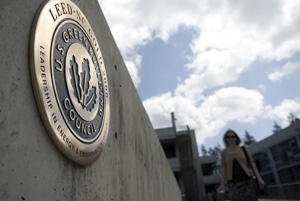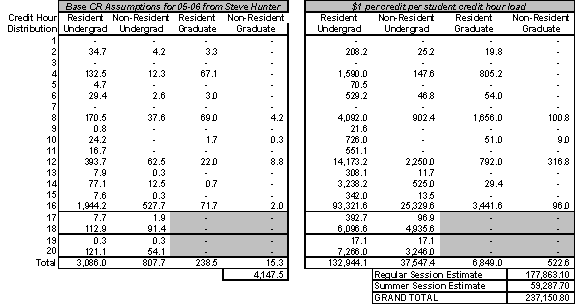Clean Energy Initiative
Legal authorization to consider voluntary student fees
Evergreen standards for student elections
Legal responsibilities of the Board of Trustees
Fund classification
Accounting for fee collections
Baseline revenue estimates (FY 2005-06)
Distribution of funds
Appendix 1
Appendix 2
Legal authorization to consider voluntary student fees:
The Clean Energy initiative is allowed under RCW 28B.610 that authorizes students to voluntarily maintain upon themselves a student fee for student purposes only.
Evergreen standards for student elections:
Past precedents of both the WashPIRG and the bus pass have set the standards for this election. This requires a petition with 25% of the currently enrolled students before the initiative will appear on a student ballot. Gateway (Banner Registration system) was used to facilitate this election. Banner is secure and can be used to instantly verify and authenticate voters. The standard of 25% affirmative votes of the entire eligible student population was the minimum needed to validate the election, and a majority vote is needed to pass the motion.
Results of the Winter 2005 Student Election:
The Clean Energy Fee election had 25% participation and, of those who voted, 91% voted yes.
Legal responsibilities of the Board of Trustees:
RCW 28B.40.120 prescribes the responsibilities of The Evergreen State College Board of Trustees for maintaining full control of the state college and its property of various kinds. Although the Board has the authority under RCW 28B.10.258 to exercise authority to delegate certain aspects of the college operations to the President, they reserved by Resolution No. 2002-02 several major policy making functions that are of a long-term strategic nature.
The Clean Energy Fee and Program Proposal will require formal board action given the following reserved authorities in Resolution No 2002-02 (emphasis added):
1. To review and approve all changes to the strategic/long-range plan, operating budget requests to the governor and the legislature, and operational expenditure plans regardless of funding sources.
6. To approve all elements of the college campus master plan, 10 year long-range capital plans, modifications to the 10 year long-range capital plan that vary by more than 5% for each individual program project of preservation category, biennial capital budget request, and capital spending plans regardless of fund source. (Program projects include remodeling to change or improve the use of existing space, or creating a new facility. Preservation projects maintain and preserve college facilities, and do not significantly change the program use of the facility.)
10. To authorize self-supporting programs, services and facilities. (Funding for self-supported programs is generated by the users of the program through general fees or through payment-for-services fees. Housing, the bookstore, food services, parking facilities, student activities, and summer school are examples of self-supported programs or services.)
25. To approve student fees.
Fund classification:
In review of the Washington State Administrative & Accounting Manual the college has determined that the Clean Energy Fee collections would be appropriately classified as Local Dedicated Activity given the explicit program purpose.
Accounting for fee collections:
Upon board approval of the new fee proposal, the Business Manger will be responsible for administering the student fee collection procedures and will establish a new unique fund/organization account in the college’s Banner financial systems to uniquely account for the new dedicated revenue collection activity.
Implementation of the new fee will require up-front adjustments to:
- Set-up new detail codes in Banner Student System (Student Accounts)
- Set-up Banner fund/organization codes in Banner Finance (Accounting)
- Test new system set-ups before implementation (Student Accounts)
As on an on-going activity, the student account office will be responsible for monitoring new detail codes to ensure the fee assessments are accurate. Student accounts will also be responsible for answering inquiries from current and prospective students and their parents about the purpose of the mandatory fee. The business manger’s office will be responsible to coordinating the development of an annual financial report disclosing all transactions associated with the program. The business manager will manage the fund accounting and make transfers according program activities based on approved policy.
Baseline revenue estimates (FY 2005-06):

Distribution of funds:
Expenditures for the program shall not incur until sufficient revenues are collected to maintain a break-even of positive cash position. All residual balances will carry forward into the next accounting period to support the program aspects as reflect below:
1. OVERHEAD CHARGE: Consistent with other similar fee collection impacts, the business office will recover from the fees collected for Clean Energy Program a small administrative overhead charge. The maximum charge is set at a fixed amount of $7,500 per-year consistent with the amount in place for the student bus program fee. After the first year the business manager will assess the impact to the department of administrating the fee collection activities to consider the prospects of lowing the per-year charge based upon actual experience.
Cost Basis for Initial Overhead Amount:
# of hours to accomplish set-up 300 hours
Hourly Wage & Benefit Cost
Total Cost Estimate for Year 1$7,500
An additional $2,500 will be collected for the purpose of maintaining the Clean Energy Committee and paying student stipends. $750 per year will be allocated the Student Clean Energy Coordinator, and $450 per year for the three other student committee members (stipend total = $2100). $400 will be used for copies of proposal and related information, plus for printing pamphlets and advertisements. See committee decription below.
2. GREEN ENERGY PROGRAM: Each quarter after final tuition and fee payment deadlines are passed, the Business Manager will transfer 90% of the remaining revenue to the college’s utility budget to cover the costs of participating in Puget Sound Energy’s and Tacoma City Light’s Green Power Program. The Director of Facilities will be responsible for administering all aspects of this part of the clean energy program. The Director of Facilities will provide an energy profile report annually that will reflect progress that the ‘Green Tags’ purchases have made towards reaching overall program goals.
Facilities will enter into an agreement with PSE & TCL that will:
- Cover a 12 month period beginning October 1st
- Permit reconciliation at the end of the agreement
- Purchase a set amount equal to 8% of goal each month for 11 months
- Reconcile the amount paid to PSE & TCL with the annual goal amount and make final payment for the year on the September billing statement.
- Ensure that the agreed upon amount of green tag purchases are itemized on PSE’s billing statements to the college.
3. CLEAN ENERGY COMMITTEE: Until such time as there is a formal student government, 10% of the remaining revenue will be transferred to the Student and Activities fund for purposes of establishing, through it’s various S&A activities, a Clean Energy Committee. The Clean Energy Committee’s main function is to allocate these specific resources for the sole purpose of creating clean energy related projects. Projects eligible for funding shall include: research into renewable energy and energy conservation technologies; clean energy projects intended to save energy or produce electricity; and demonstration projects which educate the community about sustainable technologies. However, approval for large permanent energy production installations on campus remains the prerogative of the Board of Trustees.
Moving ideas through successful implementation will require careful and deliberate outreach and communications throughout student process of allocating resources for proposed energy installations in direct consultation with the major college functional areas that would be impacted.
Clean Energy Committee Membership:
This committee will be co-chaired by the Director of Student Activities and the Clean Energy Coordinator, who will be responsible for posting meeting time and the agenda. The Clean Energy Coordinator will be responsible for posting open positions and recruiting other students to the committee.
The committee will be made up of 4 Students, the Director of Student Activities, the director of facilities, and one member of the teaching faculty. The four students have different jobs: Group Coordinator; Administrative Liaison, who also sits on the space management committee and is involved in the CLUC when necessary; Technology Researcher, who research technologies and stays current with the clean energy market; and Community Outreach, who will update the website, write articles and make publications.
Prospective committee member should apply through application that will be available through student activities, and will be publicly interviewed and then voted on by the students.
Parameters for Decision Making:
The group must have quorum to allocate funds. Quorum is reached when there and 2 students and 2 faculty or staff present in the room. Consensus is the preferred way of making decisions. Should the group be unable to reach consensus, the group has the option to employ a one-person, one-vote after a 75% agreement to suspend consensus. Non-consensus voting requires 75% approval.
Committee Meetings:
The committee should meet at least twice per quarter, during governance hours. Meetings of the Clean Energy Committee are open to the public and should post meeting times one week in advance and agenda should be posted at least 48 hours in advance.
Public Involvement:
This committee is responsible for educating the community about project proposals and allow for public comment before money is allocated. The Evergreen Community must also be made aware of any changes to the fee structure, such as changes to the percentage of the fee going to green tags compared to on-campus projects. Public communication should happen through the campus newspaper (CPJ), postings in the CAB (specifically CAB 320), email lists (tesccrier) and the Clean Energy Fee website.
Further public communication will be made through the Clean Energy Fee website. The website should be used for posting the meeting agendas and minutes. The website will display and explain all funded projects and will be the preliminary clearinghouse for proposed uses of the fee.




